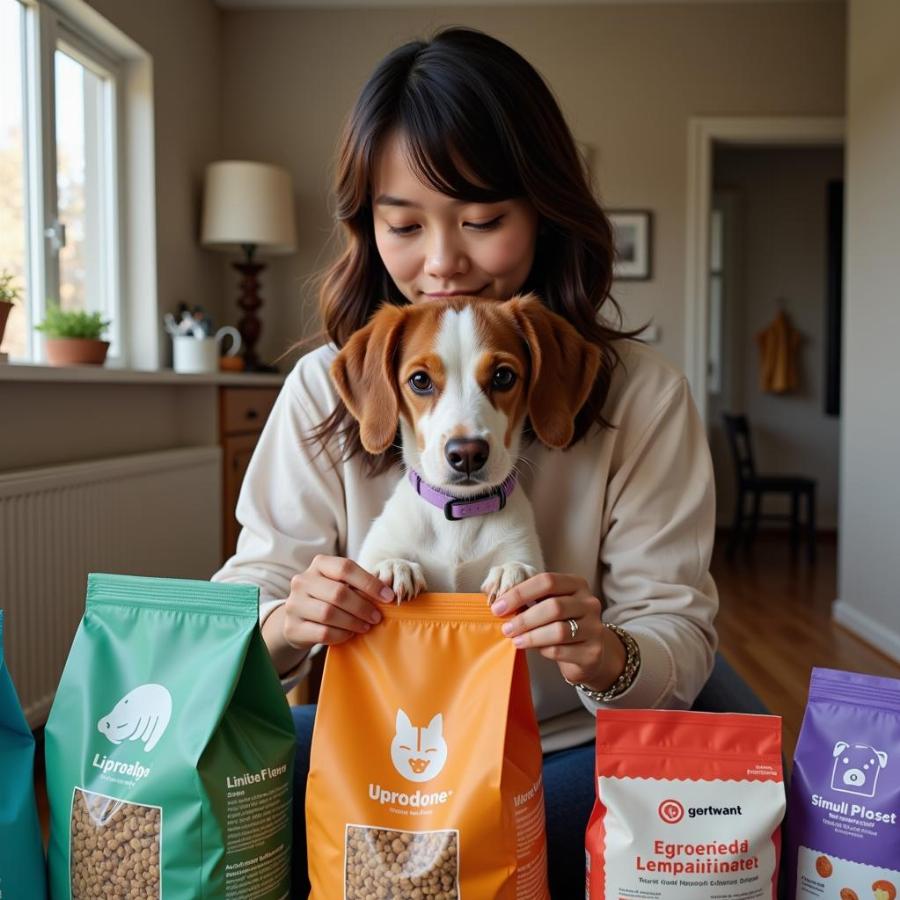Dealing with dog allergies can be a frustrating experience for both you and your furry friend. Itchy skin, digestive upset, and chronic ear infections are just some of the common symptoms that can significantly impact your dog’s quality of life. Limited ingredient dog food for allergies is often a crucial part of managing these symptoms. By simplifying your dog’s diet, you can pinpoint potential allergens and provide relief from their discomfort. This article will delve into the world of limited ingredient dog food, offering insights, tips, and expert advice to help you navigate this important aspect of canine health.
Understanding Limited Ingredient Dog Food
Limited ingredient dog food (LID) focuses on minimizing the number of ingredients, typically excluding common allergens like beef, chicken, wheat, corn, and soy. This simplified approach helps identify and eliminate potential triggers, making it easier to manage food allergies and sensitivities. Choosing the right LID food can be a game-changer for dogs struggling with allergies.
Why Choose Limited Ingredient Dog Food?
Is limited ingredient dog food right for your dog? Well, if your dog suffers from allergies, LID food can offer significant benefits. It allows you to control exactly what your dog is consuming, minimizing exposure to potential allergens. This can lead to a reduction in allergy symptoms and improve overall health. LID food can also be helpful for dogs with sensitive stomachs, as the simplified recipe is easier to digest. dog allergy to chicken
Choosing the Right Limited Ingredient Dog Food
What should you look for when selecting a limited ingredient dog food? The first step is identifying the specific ingredients your dog is allergic to. Once you know the culprits, you can choose a food that excludes them. Look for a single-source novel protein, such as venison, duck, or kangaroo, and a single carbohydrate source like brown rice or sweet potato.
Key Considerations for Selection
- Novel Protein: Opt for proteins your dog hasn’t been exposed to before.
- Limited Carbohydrates: Choose easily digestible carbohydrates.
- No Artificial Ingredients: Avoid artificial colors, flavors, and preservatives.
- High-Quality Ingredients: Ensure the ingredients are sourced responsibly and are of high quality.
 Chủ sở hữu chó đang xem xét các loại thức ăn cho chó có thành phần hạn chế
Chủ sở hữu chó đang xem xét các loại thức ăn cho chó có thành phần hạn chế
Transitioning to Limited Ingredient Dog Food
How do you switch your dog to a new food? Introducing a new food should be a gradual process to avoid digestive upset. Start by mixing a small amount of the new food with your dog’s current food. Gradually increase the proportion of new food over 7-10 days until your dog is eating only the LID food.
Tips for a Smooth Transition
- Gradual Introduction: Mix the new food with the old gradually.
- Monitor for Reactions: Watch for any signs of allergies or digestive issues.
- Consult Your Veterinarian: If you’re unsure, talk to your vet for personalized advice.
“When transitioning to a new diet, patience is key,” advises Dr. Emily Carter, DVM. “A gradual approach minimizes the risk of digestive upset and ensures your dog adapts comfortably to the new food.”
Long-Term Management with LID Food
What are the long-term benefits of LID food? Once you’ve identified and eliminated the allergens from your dog’s diet, you can expect to see a significant improvement in their allergy symptoms. LID food can contribute to healthier skin, a shinier coat, and improved digestion. best dog food for labs
Maintaining a Healthy Diet
- Regular Check-ups: Schedule regular vet visits to monitor your dog’s health.
- Supplements: Consider adding supplements like omega-3 fatty acids for skin and coat health.
- Treats: Choose treats that are also limited ingredient to avoid introducing potential allergens. dog food for large breed
Conclusion
Limited ingredient dog food can be a highly effective solution for managing dog allergies. By simplifying your dog’s diet and eliminating potential allergens, you can significantly improve their quality of life. Remember to consult your veterinarian for personalized advice and guidance. With the right approach and a little patience, you can help your furry friend live a happier, healthier life free from the discomfort of allergies.
FAQ
- What is the difference between limited ingredient and hypoallergenic dog food? Hypoallergenic dog food uses hydrolyzed proteins, broken down into smaller pieces to reduce the risk of allergic reactions. Limited ingredient food focuses on minimizing the number of ingredients.
- Can I make homemade limited ingredient dog food? While possible, it’s crucial to consult a veterinary nutritionist to ensure a balanced diet.
- How long does it take to see results with LID food? It can take several weeks to see significant improvement in allergy symptoms.
- Is LID food more expensive than regular dog food? Generally, yes, due to the higher quality and specialized ingredients. pallet of dog food
- Can LID food be used for puppies? Yes, there are LID options formulated specifically for puppies. ol roy wet dog food
Beaut Dogs is your trusted source for all things dog-related. We provide expert advice, helpful resources, and a wealth of information to help you care for your canine companion. For personalized support and answers to your specific questions, contact us via Email at [email protected]. Beaut Dogs is dedicated to helping you navigate the world of dog ownership and ensure your furry friend lives a happy, healthy life.